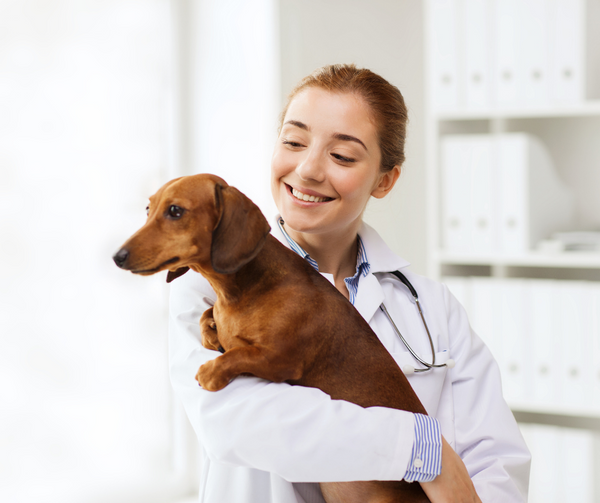
Recognizing Obesity in Pets
(by Dr. Iulia Mihai, DVM) Many cats and dogs around the world are slightly above the normal weight limit for their breed and height. Some people often find animals that look like fluffy barrels or squishy balls funny, but when does that extra weight become a health concern?
Because we see them grow from when they were just a ball of fluff, it will never seem to us that our pet is overweight or obese. OK, maybe just a little! For example, every time my friend sees my cat, she tells me how fat she is, only that I contradict her by telling her that she is slightly overweight and her cat is too skinny! The point is that we always find excuses for our pets being a little (or more) overweight.
And I'm not just saying that, it is what the polls show! A survey that ended in 2019, conducted in 8,000 households, highlighted the following:
- 68% of pet owners were convinced that their pet is at the ideal weight;
- 67% of them were not worried about pet obesity;
- 8% admitted that their cat or dog would need to lose some weight;
- 57% of pet owners had not discussed about obesity and the complications of this disease with their veterinarian;
- 50% judged the weight of the animal just by looking at it, with only 16% of them admitting that they guessed;
- Only 12% looked at the body condition chart;
- Only 2% weighed their pet (1)
We often associate food or treats (given in excess) with love for our pets, and that's because we see them as family members. But this is not the case! We show our love if we keep them healthy and active, with a proper diet, and exercise… and of course, with many kisses and hugs!
In any case, obesity in animals is a cause for concern for the owner because it can lead to serious internal problems for the animal, and sometimes it can be fatal. Let’s more closely examine the diseases associated with obesity and how to recognize an obese pet.
What is Obesity?
Medically speaking, obesity is defined as an excess accumulation of adipose tissue (fat tissue) in the body, being the most common nutritional disorder in pets. According to statistics (conducted by the Association for Pet Obesity Prevention), the incidence of obesity in pets in 2018 was 60% in cats and 56% in dogs. (2)
Obesity is most often the result of excessive dietary intake and/or lack of physical activity (sedentary lifestyle). It may also occur from a genetic cause, due to a slow metabolism, or it can be secondary to certain diseases like Cushing syndrome or hypothyroidism.
For your pet to be considered obese, it only takes a few extra kilograms (lbs.) over its ideal weight. The ideal weight is the correct weight that the dog or cat should have, depending on its breed and size. A dog considered obese if its weight is 20% higher than its ideal weight, and for cats 15% higher than its ideal weight is considered obese.
For example, if your dog's ideal weight is 9 kg (about 20 lbs.) for his breed and height, 20% of this weight would be 1.8 kg (4 lbs.). For a cat of 4.5 kg (10 lbs.), 15% will represent 700 g (1.5 lbs.). So, at first glance, 1.8 kg (4 lbs.) extra for the dog or 700 g (1.5 lbs.) for the cat doesn't seem much at all! But if these animals carried on their back sacks weighing 1.8 kg or 700 grams respectively, that extra weight won't be that insignificant anymore. The extra pounds will add stress to the joints and also force the heart and lungs to work harder.
Being overweight can lead to an incredible number of health problems in dogs and cats. Overweight and obese dogs are expected to live shorter lives than their healthy, normal-weight congeners, and obese cats are twice as likely to die at middle age (6-12 years).
Causes of Obesity in Pets
As we mentioned at the beginning of the article, the causes of obesity in pets are multiple, but the main one worldwide is the imbalance between diet and energy consumption. In other words, pets consume more calories than their body needs for how physically active they are.
Animals begin to exercise less as they get older, and this lack of activity may be due to certain diseases such as articular problems (arthritis) or heart diseases (in heart diseases, animals usually get tired at the slightest effort). Consumption of fatty foods, treats, or leftovers from your dinner can also lead to obesity.
Other common causes of obesity are:
Spaying/neutering - sterilized pets are prone to weight gain because of the loss of the hormones (estrogens and androgens), which causes a decrease in the metabolism rate and leads to a lower energy requirement.
Cushing's disease (hyperadrenocorticism) - the high cortisol levels will redistribute fats in the body (especially on the chest, stomach, and face).
Hypothyroidism - thyroid hormones regulate some of the important body functions such as cardiac, thermoregulation, respiration, etc., and metabolism (in hypothyroidism the metabolic rate decreases).
How Do We Recognize Obesity in Pets?
It is difficult sometimes for pet owners, who spend a lot of time with their beloved friend, to detect the signs of obesity. When you see your pet every day, you may not notice that they gained a few extra pounds.
The most visible symptoms are excess fat, weight gain, lack of desire to move, heavy movements, joint pain, etc., but here are some objective ways to find out if your pet is overweight:
1. Rib testing
- You should be able to feel its ribs and spine without exerting pressure. If you have to apply pressure, your pet is overweight
- The lack of the presence of the abdominal line, replaced by a straight line or a flaccid area in the stomach, is a sign of being overweight. Also, a straight line from head to tail or a curved line in the back area is another sign of being overweight.
- Other signs of obesity include: folds at the base of the tail, the skin begins to fold around the face and under the chin, fat deposits appear in the sternum area, etc.
3. Watch your animal in action
- Extra pounds can reduce your pet's activity level. Watch to see how your pet gets up from the ground, how it walks, and how active it is during the day. If your pet prefers to sleep or sit on the couch instead of wanting to play or go outside (in addition to gaining weight), it might indicate that they are overweight.
Signs of Obesity in Dogs:
- They become slow and have difficulty moving.
- It is difficult for them to do daily physical exercises, such as recovering a ball, running in the park, etc.
- They begin to show less and less interest in physical activity or play.
- Eating is an obsession.
Signs of Obesity in Cats:
- May look tired and lazy.
- It is difficult for them to jump on the furniture or climb stairs, jump in the bed, on the couch or chairs, etc.
- They may start to look unkempt/messy - dull hair on the back or tail.
- They can get tired quickly when you play with them, or they can lose all interest in play.
What to Do if Your Pet Dog or Cat is Overweight or Obese:
- Find a balance between diet and daily exercise. If your pet eats more calories than it needs in terms of energy, it will gain weight; if it eats fewer calories than its body needs, it will lose weight.
- Feed your pet quality food that has no fillers.
- Exercise with your pet every day (walks in the park, playing ball, playing around the house, etc.). Healthy cats should exercise at least 15 minutes each day and dogs 30 to 60 minutes, depending on their breed and size.
- If your fluffy friend has a great love for treats, opt for the natural ones.
- Fresh water should be given daily. Change your pet's water each day. Hydration plays a vital role in supporting good digestion and overall health.
- Weigh your pet regularly - whether you take it to the vet's office or weigh him at home. As you probably know, it is easier to maintain a certain weight than to lose weight.
- Schedule annual medical checkups. When the pet is young (puppies/kittens and young adults), one medical checkup per year is enough. If your pet is considered a senior, you should visit the vet's office once every six months.
- Determine the breed of your pet if possible. Some are more susceptible to weight problems and obesity. In cats, obesity is more common in mixed breeds than in purebreds. Among dogs, a few breeds whose weight should be constantly monitored are Basset Hounds, Labrador Retrievers, Golden Retrievers, Dachshunds, and American Cocker Spaniels.
Smart Pet Nutrition
Pets today face the highest ever rates of pet obesity, diabetes and heart disease because of highly processed, mass-produced pet food. At Spring Naturals, we believe that love is honest nutrition.
Because we love our pets
Only real meat. No meal
Grain Free
Always whole foods
Never any fillers, by-products, or split proteins. EVER
Shop our selection of nutritious, low-carb, low-glycemic foods at SpringNaturals.com.
References
- https://www.pfma.org.uk/_assets/docs/White%20Papers/PFMA-Obesity-Report-2019.pdf
- https://petobesithyprevention.org

Post a Comment!